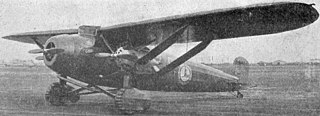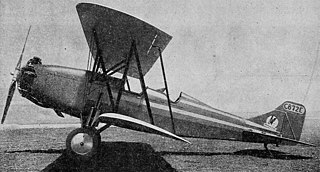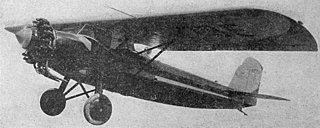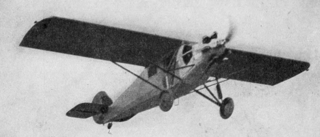
The Stearman LT-1 was a late 1920s American biplane, carrying four passengers plus mail.

The Emsco B-2 Challenger was a US three-engined, six passenger aircraft flown in 1929. Only two were built and they were quite soon converted into two different Emsco types, one with one engine and the other with two.
The Yackey Monoplane was an American three seat parasol monoplane flown in the late 1920s. Two prototypes had some success in the 1927 New York - Spokane National Air Derby and orders were placed but a crash killed its designer and ended production.

The Thunderbird W-14 was a small, three seat American passenger transport, first flown in 1926, entering production, significantly improved, in 1927 with several different engine options. About 40-50 were built before the financial collapse of the company in 1929.
The Stiles Dragon Fly was an American two seat monoplane aircraft of the late 1920s. It was aimed at private and club owners. Significant production was planned but few were built.
The Pacer Monoplane was a parasol wing, four seat, light aircraft, flown and produced in the US in the late 1920s.
The Simplex Red Arrow was a US single-engined monoplane produced in the late 1920s and early 1930s and intended as club machine or mail transport. Most used radial engines in the 90–110 hp (67–82 kW) range. They carried one or two passengers whose seats could be open or enclosed. One variant, the Red Arrow Dual Plane, was easily converted from monoplane to biplane and was available with two versions of the much more powerful Wright Whirlwind engines. In all about 20 were built.

The 1929 Curtiss Model 53 Condor, also known as the Curtiss Model 53 Condor 18 or the Curtiss CO Condor, was a civil passenger version of the Model 52 Condor bomber. A twin-engined biplane, it carried 18 passengers.

The American Eagle Phaeton was an American three seat, single engine sports biplane produced from 1929 until American Eagle failed financially in 1932. About 34 were built.

The Southern Air Boss was a 1920s U.S. biplane trainer aircraft. One prototype was built and by 1929 a new factory was ready for its production but this did not follow.

The McMullen Mac Airliner was a late 1920s American light airliner powered by a Liberty L-12 V-12 engine of World War I origin. The sole prototype was destroyed in a hangar fire.

The Moreland M-1 was a 1929 U.S. three seat civil aircraft. Only four were built.

The Neilson NC-1 Golden Bear, aka Neilson Coach was an American, three-place, high wing cabin aircraft, flown in 1929. It did not go into production.

The Wallace Touroplane was a late 1920s U.S. three seat, high wing cabin monoplane. About 20 were built.
The Watkins Skylark was an American low-wing, cantilever two-seater designed for private and club use. A large anticipated production run in 1930 ended early when the company collapsed in the Great Depression, with only five or six registered.

The Zenith Albatross Z-12 was a large, three-engined airliner built in the United States in 1928. It could carry up to 11 passengers. Only one was completed.

The Ireland Privateer was an American, 1930s, two-seat, single pusher-engined sports flying boat which could be equipped as an amphibian. About 18 were built.

The Ireland Neptune was a four or five place pusher configuration biplane sold in flying boat and amphibian versions. Designed in the U.S. and first flown in 1927, well over 50 were built.

The Lincoln AP was a U.S., single engine, high wing, general purpose civil cabin aircraft first flown in 1930. Only four were built.

The Ogden Osprey was a three engine, high wing monoplane airliner which seated six. Designed in the United States and first flown in the spring of 1930 or earlier, six were built and some used commercially before Ogden Aeronautical ceased trading in the Great Depression.















